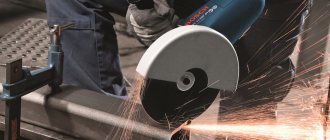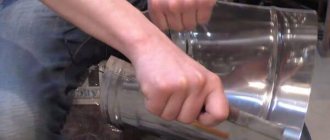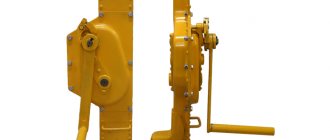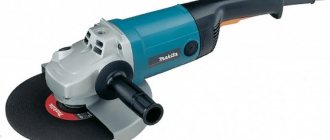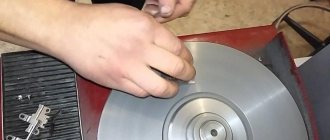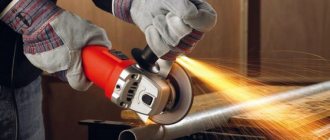This summer I was planning thorough work with the grinder, deciding which abrasive wheels to purchase and looking for information on the Internet. In the process, I accidentally stumbled upon some creepy facts that are not for the faint of heart.
The understanding has come that injuries when working with an angle grinder occur regularly and are the rule, not the exception. Both young, inexperienced guys and mature men work carelessly and get injured.
On mastercity.ru there is a thread “death from an angle grinder” in which sad content regularly appears...
Generalized information on the topic of how to work correctly and safely with an angle grinder, as well as conclusions from personal practice, are presented in this material. Let's go in order.
Introductory part. Young fighter course
Grinder, also known as angle grinder (angle grinder). Brief information for those who hold this capricious instrument in their hands for the first time.
1.1. Grinder device (angle grinder)
- On/off button
- Spindle stop button (spindle rotation is blocked when the tool is turned off when replacing abrasive discs)
- Lever. Rubberized as in the photo. An angle grinder produces noticeable vibrations during operation.
- Protective cover. Removing it is strictly prohibited!
- Air channels. Try not to overlap them with your palms so as not to overheat the angle grinder.
- Abrasive disc. In this case, grinding.
Do you know why the Bulgarian is called the Bulgarian?
The proper name “grinder” appeared in the 70s of the last century, when the first representatives of this type of instruments, produced in Bulgaria, arrived in the USSR. They were called "Fortune".
Bulgarian, now Sparky, was the first in CMEA to begin production of this type of power tool, purchasing an AEG license in 1966.
1.2. Actions with an angle grinder. What can you twist and change?
Some models provide the design ability to change
1.2.1. Handle position
1.2.2. Guard position
But never remove it completely!
Very conveniently made by the Japanese (Kawasaki). In a couple of seconds you can rearrange without a key.
The click system also looks interesting, but I personally have not had to use it.
Attention!
If you found it in a garage, received it at a factory, borrowed it from a neighbor, or somewhere else you came across a used grinder without a protective cover, then refuse the job or arrange for it to be available. Never work without a protective cover!
1.2.3. Speed adjustment
There are excellent angle grinders on sale with a speed controller. I use it myself and highly recommend it. Economic considerations are also useful here - the consumption of abrasive wheels will be 2-3 times lower.
If your grinder does not know how to regulate the speed itself, then look for an adjustable autotransformer (LATR), many people use homemade ones. With this device you can overcome the frantic speed of the grinder and even turn it into a polishing machine.
1.2.4. Replacing the drive
We change the disk as follows:
- We de-energize the tool (you can simply unplug it from the socket)
- Press the spindle stop (see the grinder device above)
- Use a special wrench to unscrew the lock nut.
This not the most convenient option will be on your grinder by default. When you get tired of turning with a wrench, purchase a modernized nut with a spring-loaded base that clamps the disk. Chinese junk, pay once for AEG, BOSCH or Makita .
Features of cutting different types of metal
Cutting cast iron and non-ferrous metals, carbon alloys is carried out somewhat differently. This is due to their special mechanical properties. When cutting metal, hold the grinder correctly at an angle of 30-40 degrees relative to the surface being processed.
Cutting metal with a grinder
In addition, it is important to choose the most suitable circle correctly. For example, a version designed for non-ferrous metals, even when working correctly with cast iron, wears out within a few minutes.
Types of abrasive wheels and attachments for grinders. Which ones do we use in our work?
Read here about the marking of abrasive discs >>>
2.1. By type of work
2.1.1. Cutting wheels
The name here speaks for itself and the purpose of the disk is intuitive. If you've seen it at least once, you won't be confused. This type of wheel is potentially the most dangerous for the operator.
To cut accurately, you have to look at the plane of the cut with the risk of getting a piece of debris in your forehead if the cutting wheel falls apart into fragments. Below is a photo of an excellent device that allows you to level out this annoying drawback.
2.1.2. Grinding wheels
Designed for grinding surfaces. Welders use it to remove slag from the weld seam. Visually it looks like a very thick cutting disc, but of course it is not. We'll talk about labeling separately.
2.1.3. Roughing
2.1.3.1. Petal circle (petal)
It has a characteristic ribbed surface.
It copes well with roughing work and grinding flat and end surfaces.
2.1.3.2. Peeling attachments
Not abrasive wheels, but I would like to mention these indispensable things when processing hard-to-reach surfaces, such as the inside and corners of a U-shaped profile.
It is highly advisable to work with grinding attachments on angle grinders with a speed controller, as ultra-high angular speed in this case is not needed and only interferes - it gives strong vibration and knocks the tool out of your hands.
2.1.3.3. Polishing wheel
The quick-change abrasive material is fixed on a special sanding plate base using Velcro and is used to eliminate small defects.
2.2. By size
Take a look at the instructions for your angle grinder and read which discs you need to purchase. Size - the outer diameter of the disk depends on the size of the grinder for which it is intended and can be:
- 115 mm. The most portable option. It is usually purchased for grinding work, since the depth of cut with a new cutting disc does not exceed 30mm. In this case, the disk wears out during operation and its diameter will be even smaller.
- 125 mm. A popular and most common option for the range of house-dacha work. A successful combination of compactness and power with a light weight angle grinder. A wide range of circles and attachments for this size are on sale.
- 150 mm. Average Bulgarian.
It’s no longer suitable for delicate work, but it’s not yet mature enough for professional work. The capabilities of a 150 mm angle grinder are completely covered by its counterpart with a diameter of 180 mm, therefore an angle grinder designed for an abrasive wheel with a diameter of 150 mm is classified as a highly specialized and not the most practical power tool for widespread use. - 180 mm. Copes with relatively thick metal structures and large diameter pipes.
- 230mm. For household needs it is rarely required, but accurately. Not suitable for finishing work. Very convenient for processing large masses of stone: cuts concrete beams, stone, brick. It features an impressive cutting depth of up to 70mm and the ability to clean large surfaces. The average weight of such grinders is about 5 kg, which imposes obvious physical limitations.
The thickness of the cutting disc is from 1 to 3.2 mm. It is difficult to give unambiguous recommendations for choice; here everyone decides independently based on the tasks at hand and personal preferences.
The thinner the cutting disc, the easier it is to cut, but the faster the wear of the working surface (more often you need to install a new disc) and for some reason they often write on forums that there is a higher probability of destruction when the disc is skewed (the worst thing), but according to my observations, on the contrary, a thin disc is more flexible and “plays” due to reinforcement.
The smaller the diameter, the higher the operating speed of the angle grinder. For example, grinders 150 and 125 differ not only in the size of the protective casing, but also in the gear ratios of the gear pairs. The use of a disproportionate disc, for example from 150 for a 125mm angle grinder, is strictly prohibited!
2.3. According to the processed material
2.3.1. For metal or concrete
Inscription (“steel” – disc on steel, “concrete” – concrete). In our case, the inscription is duplicated in Russian and English. Color (blue for steel, green for concrete), sometimes there is a graphic representation of the material.
2.3.2. On wood
Never use saw blades for woodworking on an angle grinder! More recently, this far from successful idea could only be realized by individual craftsmen who created homemade spacers for installing a circular saw blade on an angle grinder.
Today you can find on sale metal cutting wheels for woodworking that are structurally suitable for your tool in terms of the mounting inner diameter, which creates the illusion that “the manufacturer knew what he was doing,” but not a single intensive care doctor would agree with this.
People get the most terrible injuries when using an angle grinder in chainsaw mode. When it hits a knot, the disc becomes wedged and the angle grinder is torn out of your hands in a split second, flying along an unpredictable trajectory. Here is a similar case, only the role of a knot here was played by a nail.
A friend of mine decided to cut the already installed MDF panels, which were bent due to dampness - he screwed up the disc from the circular saw onto the grinder.
I sawed off the first two panels normally, but on the third panel I got a tiny nail (finish) and the grinder was torn out of my hands. The result is a completely torn knee and disability for 20 years.
Quote from the forum price-altai.ru
Important! Cut wood only with a gas, electric, circular saw or hand saw. In this case, give up the versatility of angle grinders in favor of your own safety!
How to avoid the risk of injury from a defective disc
To reduce the likelihood of injury, pay attention to the following points:
- Correctly check the condition of the nozzle each time before using it.
- You cannot use used nozzles.
- Work should only be carried out using various protective equipment, for example, goggles or a protective mask.
Possible injury due to careless handling of the grinder
People who have problems with motor coordination or who are at risk of sudden onset of seizures should not use the tool in question.
A few personal recommendations for abrasive wheels
3.1 On your own blacklist
Cutting yellow-blue wheel Lugaabrasive is a product of JSC Luga Abrasive Plant located in the city of Luga, Leningrad Region.
The only advantage of the disk is the price, which is offset by the phenomenal speed of its grinding. It is more profitable to purchase a more expensive one with a high-quality abrasive and work as usual than to change one Luga abrasive to another every 2 minutes. In addition, there were discs with different cutting edge thicknesses and imbalances, which resulted in terrible geometry in operation.
By the way, here in the photo there is a piece of debris in a man’s head from this disk, and below we will talk about personal protective equipment and the case with a mechanic’s mask being pierced through the shield occurred again from the yellow-blue Lugaabrasive disk. It remains unknown what people sawed and whether they cut correctly, but I don’t want to check it myself again.
Oddly enough, but in tests available online, the Luga-Abrasive Extra wheel shows quite decent cutting coefficients. In addition, other products of the Luga plant may deserve attention.
On one of the construction forums I had to read good reviews about gray-black wheels from the same manufacturer, marked professional. Personally, I haven’t had to cut with them, but I trust the user who responded positively.
The same plant produces very decent Hitachi disks. Apparently the quality control of the Japanese brand is not asleep.
3.2 My choice
Discs that are a pleasure to work with. I first tried high-quality wheels at work when I was working as part of a team working as a contractor for a German office. Since then, I haven’t even looked at the cheap abrasives with which all hardware stores are littered.
Compared to budget options, the price of European quality is exactly 10 times higher, but you will understand what you paid for if you hold it in your hands:
3.2.1 Hilti
3.2.2 DRONCO (Germany)
By the way, expensive disks have a significant margin of safety and, for example, BOSH products, video tests of which can be found on YouTube, can withstand a double (!) number of revolutions before breaking.
Correct tool position
Cutting with a grinder must be safe, so there are some requirements for the position of the tool in space:
- The angle grinder should be held comfortably and firmly with both hands.
- Take a stable position so that you can hold the equipment in your hands in the event of heavy loads or impacts.
- The grinder should be taken in such a way that the cut area is not in front of the operator, but to the side. If the cutting wheel jams, the rotating cutting tool will be thrown to the side.
In the video you will learn how to cut correctly: from yourself or towards yourself:
What to do to prevent the disk from breaking into fragments
4.1. Learn proper cutting technique
If the disk is bitten, then the expensive disk will shatter into pieces just like the cheap one.
You will find practical advice on individual skills in working with angle grinders at the end of this article.
4.2. Transport abrasive wheels as gently as chicken eggs
Usually the honorable duty of carrying an instrument falls on the shoulders of the youngest and therefore inexperienced guys. Carry out an educational program and make sure that the discs are not lying around in the bag at the very bottom under the weight of the grinder and other tools.
4.3. At the work site, place the removed and spare discs so that no one will trample on them.
It’s strange to read such a situation only on paper; in practice, I have repeatedly observed a negligent attitude towards consumables even among experienced and smart men - seasoned production workers. Ignore the sneers or show a photo from the Internet on your phone - those who want to be ironic will disappear. Verified.
4.4. Do not distort the abrasive wheel when replacing it
On a de-energized angle grinder, when unscrewing the lock nut, the hand itself rests on the flat surface of the disk and it strives to bend “to the point of breaking.” You most likely won’t break the disk in half, but there is a chance of creating microcracks that will lead to a rupture in subsequent work.
Classic "garage" situation. The piece of iron was cut off and needs to be cleaned. There is only one grinder, which means you need to remove the cutting disc and install it as a stripping disc. The cutting tool is biting in the work and effort is needed. We apply it with all our hearts, but in the process we don’t notice how we have warped the disk and caused damage invisible to the eye. When we put this disk back, the likelihood that it will shatter into small pieces will be many times higher.
4.5. Monitor the disk status during operation
After stopping the rotation, shoot your eye over the entire working surface of the abrasive. If there are chips, cracks or the cord is visible, don’t hesitate to throw it away.
4.6. After long-term storage
If the abrasive wheel has absorbed moisture, then its strength and ability to maintain high speeds drops critically. The ubiquitous condensation can get on it both in the store’s warehouse and during “winter” storage in your country house.
4.7. Best before date
Does everyone know that it even exists?
The expiration date is applied by the manufacturer to the metal part of the mounting hole on the outside. We talk about this in more detail in the material about marking abrasive wheels.
Popular questions
First of all, users are interested in the following questions, which will be answered immediately.
Angle grinder (grinder) BORT BWS-1200U-SR. Photo 220Volt
Question: Can cut-off or sanding discs be used as one attachment to sand or cut different surfaces? That is, is it possible to use one nozzle for all work?
Answer: no, this is strictly prohibited. You won't be able to save money on this.
Question: if continuous home production is organized, how much will the electricity consumption meter count?
Answer: it should be understood that grinders have different powers. For example, for a 1200 W device that will be used continuously for 8 hours a day, the power consumption will be 210 W.
Question: if you buy an industrial grinder for your home, will it last forever?
Answer: industrial electrical appliances and tools are always highly wear-resistant, but one fact should be noted: a number of devices in the industrial sector operate on three-phase voltage. Household sockets are two-phase.
Accidents
As already mentioned, the use of grinders with strict adherence to safety rules is a guarantee of maintaining health, not only your own, but also those of others. If treated negligently, the angle grinder may “lead”, the disc may split or fly off the spindle . If you're lucky, it will fly past, but it can also be stopped... by the human body, which is extremely harmful to health)))
Maintenance and repair of safe angle grinders
If you do not have the skills of an electrician, then all work related to the electrical component, such as cleaning brushes, rewinding the electric motor, etc. – it’s better to entrust it to a professional. But you can check the integrity of the casing, spindle, threads of the clamping nut and flange yourself.
How to work. Safety precautions (hereinafter referred to as TB)
I won't beat around the bush. The safety precautions for angle grinders are a complete mess. There are no clear official recommendations. According to the instructions, the grinder is a grinder, but the range of work performed by this power tool goes far beyond grinding and polishing.
Let's try to understand the security issue based on existing practical prerequisites.
5.1. Nice tool. Why you need to buy it
I am writing absolutely seriously about this aspect in the safety precautions section. Choose a strong and reliable tool. A good grinder costs only 1.5 times the subsistence minimum. On average, a healthy person in the Russian Federation earns 7.5 minimum wages month . 90 minimum wages per year .
It turns out that for a high-quality angle grinder with protective mechanisms designed by the manufacturer, you need to pay only 1.7% of your annual income. A more than reasonable investment in your own safety. Into the furnace of Chinese and cheap models!
10% in the safety of a car (alarm, Casco, etc.) .
I personally purchased a Bosch GWS. Equipped with the KickBack Stop protective system, which turns off the tool when the disc jams. That's the whole point. Also, angle grinders produced under the Metabo brand are equipped with a special coupling for a similar purpose.
Most likely Makita also has something, but I won’t say so - I don’t have accurate information on this manufacturer.
Meanwhile, if the grinder is not equipped with automatic engine shutdown when biting the abrasive wheel, then two equally unattractive options are possible:
1) The disk will fall apart and the debris will fly at a linear speed, which we will now calculate for a disk with a diameter of 125 mm and a speed of 12,000 rpm:
Diameter D = 125 mm = 0.125 m
Circumference C = pi*D = 3.14*0.125 = 0.392 m .
Frequency ν =12000 rpm = 200 r/s .
Linear speed V = C*ν= 200*0.392= 78.5 m/s
For an angle grinder with a circle diameter of 125 mm and a speed of 12,000 rpm, the linear speed of the disk fragments will be 78.5 m/s .
Previously there was a calculation error here. Many thanks to Pavel Serkov and Dmitry (unfortunately, last name is unknown) for their letters pointing out the gross miscalculation.
The resulting value is 4 times lower than the initial speed of a bullet from a Makarov pistol = 315 m/s.
2) The disk will hold up and then the grinder will be snatched from your hands, which will again turn from a construction tool into a firearm. Here, even without formulas, it is clear that a rotating disk will enter a person like a knife through butter.
5.2. Working without a casing is like playing Russian roulette
The housing should always be between you and the axis of rotation of the tool. Situations will certainly arise when the casing gets in the way, but this is not a reason to dismantle it. Use an angle grinder with quick adjustment of the protection position (I wrote about such a tool above)
In the vast majority of cases, the protective casing works like this:
The disk collapsed, bounced off the casing and the fragments ended up in a zone that was safe for the angle grinder operator, but on the contrary, potentially dangerous for his partner and other people in the work area.
Attention! Sometimes debris can “leak” through the casing or fly in through a ricochet. The presence of a casing is not a reason to forget about personal protective equipment.
5.3. Remove foreign objects
In the mid-90s, when I first picked up a one-handed grinder, I was doing my first renovation in the bathroom, cutting concrete with a diamond, and a piece of clothesline about 1.5 m long was dangling far from me.
I only felt a strong blow on the mask, and in a split second the instrument under the ceiling in the far corner screeched.
Quote from mastergrad.com forum
I think no explanation is needed, organize your workplace properly.
5.4. Individual protection means
5.4.1. HEAD. EYES
Protective glasses. Not a panacea, but better than nothing.
The author knows what he's talking about and had the dubious pleasure of walking around with a red eye while sawing tiles. Didn't fit in size. I had to trim just a little bit, I was too lazy to put on safety glasses and caught a shard of tile in my eye. It's my own fault.
It looks scary, but in terms of time it goes away approximately like a bruise on the skin and does not affect vision. This is one of the easiest and most gentle injuries that can be caused by improperly working with an angle grinder.
Safety glasses are not a panacea. Use them only if nothing else is available, but even with safety glasses when working with metal you may be surprised
Chips in the eye. Two words about first aid
The Internet is full of stories of shavings leaking into the eye even when safety glasses were worn. Blinking is very painful - the shavings scratch the eyelid and not everyone can endure it until they see a doctor. In this case, proceed as follows at your own risk:
- 1. Do not touch your eyes with your hands.
- 2. Lidocaine is dripped from a pipette into the eye (sold in ampoules at the pharmacy). It will burn a little, when the burning goes away and the pain subsides for about 10-15 minutes.
- 3. The insides of a cigarette filter are mined. Cut lengthwise at an acute angle.
- 4. Next, use the thin end of the filter to extract shavings. It is literally magnetic to this porous material and is visually clearly visible.
- 5. They instill albucid into the eye and go for a check-up with a doctor.
Protective mask - face visor
“Advanced” wear a turner’s shield, which will really protect the eyes from chips, but nothing more. Let us remember the initial speed of the disk fragments of 78.5 m/s and look at the photo from the Hansa:
I quote the author
If I tell you without snot, then the guy was lucky. The circle was cut across the eyebrow and higher on the forehead. Only soft tissues were damaged. As a keepsake, there will be a scar 5-6 cm long.
Quote from the guns.ru forum
The author of the post also posted a second photo. Initiates will easily recognize the cut-off yellow-blue circle Lugaabrasive, the quality of which has already been discussed.
Consequently, the common shield that is widely used for working with an angle grinder only creates the illusion of security and for reliable protection the plexiglass must be tens of times thicker, for example:
I found this mask with a visor made of reinforced plexiglass on the English-language Internet and didn’t even understand how to order it. In addition, delivery can cost as much as a second grinder. Is there anything reliable and affordable for our brother?
Protective shields with steel mesh look cheap and cheerful.
Here is the protective shield NBT-Euro steel.
The description states: Protects against large and small solid particles with high kinetic energy up to 15 J.
Is up to 15 J a lot or a little? How “large” and “small” particles are we interested in? Let's do some more math:
Muzzle energy is the initial kinetic energy of a bullet at the moment it leaves the barrel. The concept is found in the Federal Law “On Weapons”. Calculated using the standard kinetic energy formula:
where m is the mass of the bullet, and v is the initial speed of the bullet.
For small particles:
We take a cutting abrasive disc weighing 0.04 kg . Suppose that upon destruction it scatters into 100 equal parts of equal mass: 0.04/100=0.0004 kg
We substitute the mass of one fragment and the linear velocity known to us into the energy formula:
E = 0.0004 kg * 78.5 m/s (squared)/2 = 1.23 kg m2/s2 = 1.23 J
For large particles:
We assume that the disk splits in half: 0.04/2=0.02 kg
E= 0.02 kg*78.5 m/s (squared)/2= 61.6 kg m2/s2 = 61.6 J
Indeed, a protective mask with a steel mesh will successfully protect the angle grinder operator from small fragments: 1.23 J.
The result is the same - again we get a piece of the abrasive wheel sticking out of the angle grinder operator’s forehead. The resulting kinetic energy of 61.6 J of an abrasive disk flying out of an angle grinder 4 times higher than the maximum permissible 15 J.
It’s a similar story with masks from HUSQVARNA and REZER, and they cost 10 times more than NBT-Euro steel products.
Conclusion: there is no decent solution on the market of protective construction accessories in the Russian Federation, but we will not give up and turn our inquisitive gaze to protective army helmets.
Mask-1
It’s a funny situation, but only a bulletproof protective helmet can cope with the task of protecting the angle grinder operator’s head.
Reliability is an absolute plus, but availability is a problem - the helmet has been discontinued. In addition, the difficulties of a civilian wishing to officially purchase an army protective accessory are obvious. “From Hand to Hand”, “Avito” and other bulletin boards can help you. Friendship with warrant officers has also not been canceled 
Also a good option is purchasing a replica (copy) of any army helmet. There are quite a few online stores with such products and visually the result looks great:
ZSh 1-2M with 8mm ballistic plexiglass in two layers
Note: If I’m wrong and reinventing the wheel, and you have ever used specialized construction helmets available for purchase to a wide range of citizens, then I will be grateful and will definitely publish all the reasoned remarks of the form: I used a helmet like this, bought that there, took a blow when the abrasive wheel of such broke then sizes, etc.
5.4.2. HANDS
Quote:
The casing does not provide a complete guarantee. The last time I had a ruptured disc, my arm was a little bruised—a little bit of blood and all that. The piece hit the casing, flew off to the floor, and from the floor into my hand.
Quote from the popgun.ru forum
Standard cotton gloves will not work. Look for something dense. For example, welding gaiters or split-leaf gloves.
5.4.3. BODY
Need I say that sports tights and a T-shirt do not work with such things?
You need high-quality, thick and preferably non-flammable(!) protective clothing. The latter circumstance involves the manufacturer impregnating the fabric with a special composition with a corresponding increase in the cost of the suit.
If your wallet allows, then look towards a “welder suit” in the middle price category.
My enthusiasm for workwear increased significantly after reading some of the remarks. I quote, preserving the authors' spelling:
My patient died from sepsis. I sawed corrugated sheets in my shorts. a stream of sparks flowed along the inner thighs. on the second day I got sick. died 5 days later.
Quote from the guns.ru forum
He was young - “green”. I was cutting something round (unstable) like a (car) muffler. The piece is on the ground, I'm in a deep bend with an angle grinder above it. A sudden gust of wind and the leg of the overalls gets caught under the disk. The disc of the grinder, winding and cutting the fabric, inexorably, by inertia, creeps upward - to the male “causal place”.
With an effort of will, I stopped the grinder’s disk (1.5 kW) by squeezing my knees. And so we stand with her and butt heads: Who wins? The off button is somewhere far away in the folds of the fabric. To unplug the cord from the socket you need to take a step with your feet, which I cannot do. In general, it’s good that after a couple of minutes my partner arrived in time.
Result: the grinder didn’t burn, there wasn’t a scratch on the body, my pants were in tatters, I laughed for 2 hours. Since then, I always turn on the angle grinder through an extension cord with a button (which I advise you to do)
Quote from the chipmaker.ru forum
5.5. Grinder cutting technique. Safe individual skills
5.5.1. Cutting. Start
Never start the grinder by pressing it against the part - the tool can be torn out of your hands. Take a stable position. Turn on the angle grinder at some distance from the material, feel how the machine works.
5.5.2. Avoid being in the plane of rotation of the disk
The first and most difficult rule to master and practically implement. Especially when working with a cutting disc, in order to get to the size, it is very convenient to do the opposite - look at the disc and use it as a sight, but at the same time your head and neck themselves, in turn, will be “at gunpoint”. Here's a classic situation:
To move my eyes away from the dangerous line and look at an angle, a simple line drawn with a marker along the cut and adjacent surface helps me. It’s impossible to do absolutely all the work this way, and sometimes I still catch myself thinking that I’ve again gotten myself into the trajectory of the disc flying apart.
However, by instilling the skill of working from the correct position, I minimize the amount of time spent in a dangerous sector and therefore the likelihood of injury.
If you don't like thinking in probabilities, then use this thing:
Super! It's clearly mass-produced, but I haven't come across it on sale. If you have an old vice and a welding tool, it’s not a problem to assemble something similar yourself. Here's a homemade one:
The operating principle is intuitive. Marked, secured and just know, press the lever like on a drilling machine or a factory punch and get the following output:
- High accuracy.
- High security.
The device allows you to completely remove a person from the line of rotation of the abrasive wheel.
5.5.3. Cutting direction
Much has already been written about the notorious direction of rotation of the circle “from oneself” or “towards oneself” and there is ambiguity of opinions. There, while some people have been sawing all their lives, others consider it categorically unacceptable. My conclusion is clear: Sparks must fly “toward themselves.”
If you have picked up an angle grinder for the first time, you will intuitively do the opposite, because the sparks make it difficult to see where you are sawing, and besides, showering yourself with sparks is uncomfortable (we talked about the non-flammable welder’s suit for good reason). However:
On my grinder, I turned the gearbox over so that the sparks would fly forward and not backward. Very convenient when the sparks are from yourself. Today the disc jammed and the grinder flew back and sawed through my leg. The cut is not deep, they stitched it up quickly at the emergency room.
And only now I understood why the grinders are set from the factory so that sparks fly backwards. With this direction, when the disc is clamped, the angle grinder is thrown away from you, and not towards you.
Quote from the guns.ru forum
5.5.4. Maintaining a cut
1. We cut any material, even thin ones, in several passes.
We enter the existing cut carefully, without touching the walls with the flat surface of the rotating circle.
2. Movements are light and smooth. Experience the aesthetics of smooth, jerk-free movement. In the case of metal, the friction force melts the surface in the contact zone and the melt acts as a lubricating fluid.
If you make a careless movement, the molten film will instantly cool down and you will physically feel the unattractiveness of the “dry” cutting mode.
3. We perform the cut using rocking movements. Thus, the disk forms a small compensation gap for itself, which it will play into if it starts to be pinched. If the cut is carried out under tension, then the disk will have nowhere to bounce and it will fall apart.
5.5.5. We think with our heads
If you have ever sawed a log with an electric/chainsaw or friendship-2, then you probably know how the tool clamps the sawn wood. The same thing happens when working with metal, only the frantic speed of the grinder will turn the scattered disk into a shrapnel shot.
The material will definitely play a role in your work. Figure out where and how.
Remember about the probable rebound and backlash
Be careful in front of and behind the rotating cutting wheel. If you move the cutting wheel away from you in the workpiece, in the event of a kickback, the power tool may bounce back with the rotating wheel directly at you.
From the instructions for angle grinders from Bosh
In addition to disc clamping, rebound occurs:
- When the disk plane is pressed against the side surface of the material being processed.
- The working disc touches a foreign obstacle or slips off the surface being treated. For example, when cutting along the narrow side of a rail.
5.5.6. The art of undercutting
It is often better to undercut than to cut through. This technique is very common in professional environments.
Examples:
- When working with sheet metal, we do not make through cuts. We leave the jumper, bend the sheet and finish it without the risk of clamping the cutting disc. A similar approach can be used when dealing with rolled steel.
- If you are cutting pipes in a riser, make an incomplete cut. We burn out the last centimeters and “finish off” them by welding.
- For tiles, it is enough to mark a shallow groove on the glossy side and break it. A glass cutter successfully copes with the same task.
5.5.7. Don’t forget about the properties of materials when heated
Any 7th grade student knows that metal expands when heated. Here's the quote again:
The stone was securely fixed, I stood straight. And the disk bit as it was heating up (when it was heating up, you could see how it went straight in waves) ...
Quote from the guns.ru forum
For thorough work when sawing stone and concrete, use a “wet cut” with a grinder. This is a fairly extensive topic that we will leave outside the scope of this article.
5.5.8. Look back at your partner!
Also, do not forget about your own safety when your partner is a person without an angle grinder and that is you.
I personally observed a brigade of coven makers from Asia. The first one saws, and sparks fly down the second’s collar. Like in a joke.
For the same reason, it is forbidden to keep the angle grinder turned on outside the cutting zone. Bend down to unwind the wire, instinctively move the working area of the tool to the side - away from you and rip your partner into pieces.
And finally...
Working with ceramic tiles
The tool is often used to work with ceramics. In this case, even correct cutting with a grinder is somewhat difficult due to the low workability of the material.
Ceramic tile cutting
The disc with a diameter of 115 mm is characterized by the greatest efficiency when working with ceramics. The correct cutting speed is about 6 thousand revolutions per minute.
Operations that can be performed using an angle grinder
An angle grinder (grinder) is a tool with many functions. The drive mechanism in it is represented in the form of an electric motor, which, through a gearbox, begins to transmit movement to a shaft with a replaceable nozzle attached to it. The general view of the device is shown in the photo below. There are different models on the market and in construction stores,
which differ from each other in design and power:
- Household devices.
- Professional.
- With or without handles.
Powerful devices will be powered by a three-phase voltage of 380 V, and household devices will be powered by a standard single-phase network of 220 V. An angle grinder will help you perform the following basic types of work with various building materials:
- Cutting.
- Polishing.
- Grinding.
Interestingly, if you fix the grinder motionless, then on the wheel you can sharpen various tools, such as drills, cutters, knives and other things.
Angle grinders are designed to work with the following materials:
Metal.- Concrete.
- Glass.
- Tree.
- Stone.
- Ceramic tile.
- Plastic.
- Brick.
Grinders have become extremely popular in everyday life, as well as in industrial settings. This is due to the fact that they have wide functionality,
and is all due to the following factors:
- A huge selection of different attachments from various materials for a variety of operations.
- Possibility of creating a fixed fixation using special fastening devices.
- The presence in certain models of additional handles, as well as several speed modes for performing work.
It is important to remember that only special discs can be used to process each material.
Why you can’t cut metal tiles and corrugated sheets
The answer to this question lies in knowing the structure of these materials.
How they are constructed: they consist of thin sheet material, the surface of which is coated with a special protective composition. When cutting with a grinder, which occurs at high speed, this type of coating is destroyed. Subsequently, this will lead to corrosion at the cut site and a reduction in service life. In addition, waste products, inevitable cutting companions, will spoil the outer surface. Therefore, it is necessary to perform such work using gentle methods, for example, using a hacksaw. In the video you can see how to work with an angle grinder correctly and safely:
We ask those who carry out work using an angle grinder to share their experience in the comments to the text.
